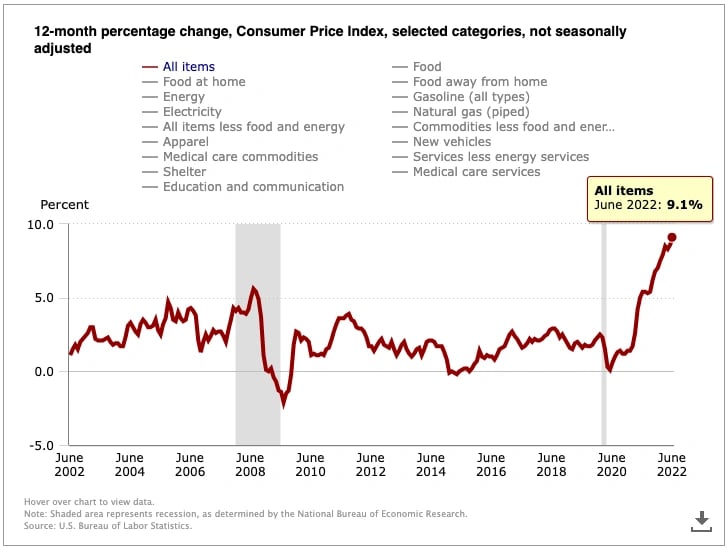위키 구독하기
Share wiki
Bookmark
Frax Price Index (FPI)
Frax Price Index (FPI)
**Frax 가격 지수(FPI)**는 2022년 4월에 출시된 Frax Finance 생태계의 두 번째 스테이블코인입니다. FPI는 미국 CPI-U 평균으로 정의된 실제 소비재 바스켓에 고정된 최초의 스테이블코인입니다. FPI 스테이블코인은 CPI 바스켓 내 모든 품목의 가격에 대한 가격을 일정하게 유지하고 따라서 온체인 안정성 메커니즘을 통해 구매력을 유지하도록 설계되었습니다. Frax Finance의 첫 번째 스테이블코인인 FRAX와 유사하게, 모든 FPI 자산 및 시장 운영은 온체인이며 알고리즘 시장 운영(AMO) 계약을 사용합니다. [4] [5]
인플레이션 및 페그 계산
FPI는 미국 연방 정부가 보고한 CPI-U 미조정 12개월 인플레이션율을 사용합니다. [1] Chainlink 오라클은 공개적으로 발표된 직후 이 데이터를 온체인에 기록합니다. 그런 다음 오라클이 보고한 인플레이션율이 시스템 계약에서 FPI 스테이블코인의 상환 가격에 적용됩니다.
상환 가격은 온체인에서 초당 증가(또는 드물게 디플레이션의 경우 감소)합니다. FPI 페그 계산율은 bls.gov [2]가 매월 CPI 가격 데이터를 발표할 때마다 30일마다 한 번 업데이트됩니다. FPI 페그는 위의 12개월 인플레이션율을 추적하고 FPI 상환 계약에서 항상 이에 고정됩니다.

계정 단위로서의 FPI
Frax Finance 프로토콜은 FPI가 암호화폐 및 비암호화폐 모두를 포함하는 상품 바스켓에서 파생된 자체 계정 단위를 갖는 최초의 온체인 스테이블코인이 되는 것을 목표로 한다고 밝혔습니다. FPI는 인플레이션에 대한 저항력이 있는 수익 자산으로 간주될 수 있지만, 주된 목적은 거래, 가치 및 부채를 표시하기 위한 새로운 스테이블코인을 만드는 것입니다. DAO 재무부를 표시하고 FPI로 수익을 측정하며 FPI 거래 쌍에 대한 성과를 벤치마킹하면 실제로 인플레이션에 대한 가치 증가가 활발하게 이루어지고 있는지 더 잘 판단하는 데 도움이 됩니다. FPI는 또한 온체인 경제를 실제 자산 바스켓에 연결하는 데 도움이 되는 것을 목표로 합니다.
현재 FPI는 FRAX로만 구성됩니다. 그러나 Frax Finance 프로토콜은 브리지된 BTC, ETH와 같은 다른 암호화폐 기반 자산과 비암호화폐 소비재 및 서비스를 포함할 계획입니다.
FPI 안정성 메커니즘
FPI는 FRAX 스테이블코인과 동일한 유형의 알고리즘 시장 운영(AMO)을 사용합니다. 그러나 항상 100% 담보율(CR)을 유지하도록 모델링됩니다.
담보율이 100%를 유지하려면 프로토콜 대차대조표가 CPI 인플레이션율 이상으로 성장해야 합니다.
AMO 전략 계약은 CPI에 비례하는 수익을 얻습니다. 그렇지 않으면 CR이 100% 미만으로 감소합니다.
AMO 수익이 CPI 비율보다 낮은 경우 TWAMM AMO는 항상 CR을 100%로 유지하기 위해 FPIS 토큰을 FRAX 스테이블코인으로 판매합니다. CR이 100%로 돌아오면 FPIS TWAMM이 제거됩니다.
FPI 제어 풀 [3]에는 FPI 및 그 페그와 관련된 다양한 보조 기능이 있습니다.
- 발행/상환: 사용자는 FRAX로 FPI를 발행하거나 FRAX로 FPI를 상환할 수 있습니다. 초기에는 0.30%의 소액 수수료가 있습니다.
- twammToPeg: twammToPeg 함수는 프로토콜에서 FPI의 시장 가격을 목표 페그 가격으로 상승(또는 하락)시키기 위한 시장 압력을 도입하는 데 사용됩니다.
- giveFRAXToAMO/receiveFRAXFromAMO: 계약은 수익(기타)을 얻는 다양한 AMO에 FRAX 담보를 대출합니다.
FPI 스테이킹
Frax Finance 프로토콜을 통해 FPI 보유자는 Fraxswap과 Convex에서 수익을 창출하기 위해 FPI 토큰을 잠글 수 있습니다.
잘못된 내용이 있나요?
